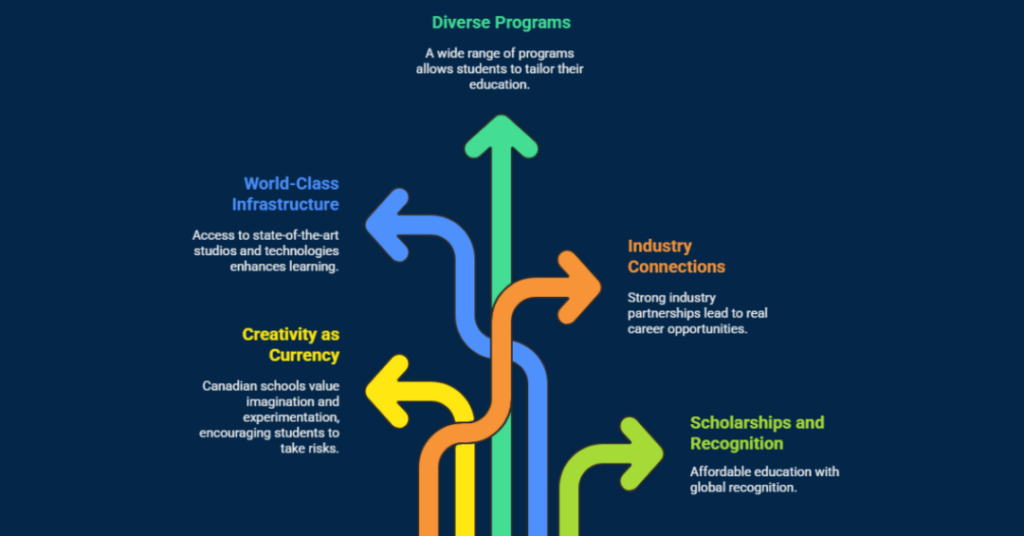30 July 2025
5 minutes read
10 Top Art And Design Universities In Canada For Indian Students In 2025

Key Takeaways
- Art universities in Canada offer hands-on learning, modern studios, and real industry exposure that actually prepares you for the job market.
- Canadian schools like UBC, OCAD U, and AUArts offer programs from BFA to MFA across digital media, interior design, and more.
- Average tuition ranges from CAD 24,000 to 42,000 with graduate salaries hitting up to CAD 75,000 per year.
“Do you want fries with that degree?” — the classic insult hurled at art and design students who dare to dream outside engineering or medicine. But in 2025, a BFA in visual communication or media arts from a top Canadian university can get you into a cutting-edge design firm in Vancouver faster than most coding bootcamps can say “Python.”
But, too many Indian students fall for big names with zero hands-on learning, overpriced degrees, and outdated faculty who still teach art history like it’s 1980. The good news? Canada’s got a fresh crop of universities — from Alberta to British Columbia — where interdisciplinary programs, world-class faculty of arts, and galleries that actually launch careers make all the difference. We’ve done the digging, so you don’t waste time (or money) chasing the wrong dream.
Why Study Art And Design In Canada?
Because obviously, if you’re not coding or cracking NEET, you must be “wasting your life drawing cartoons,” right? Welcome to the great Indian guilt trip. But while everyone else is busy chasing the same four careers, artists and designers are building empires out of ceramics, digital media, and environmental design. And guess what? Canada is their playground. From OCAD University’s downtown Toronto vibe to the studio-driven magic at Alberta University of the Arts, this country doesn’t just teach creative arts — it respects it.

So if you’re tired of being told your dreams won’t pay rent, let’s explore why some of the top art minds are choosing art schools in Canada — and thriving while they’re at it.
1. Canada’s Art Schools Treat Creativity Like Currency
While most systems rank you by how well you replicate textbooks, Canadian universities and colleges bet on imagination. Schools like NSCAD University and OCAD U are powered by faculty of fine arts who encourage failure, risk-taking, and real experimentation. Whether you’re into printmaking, digital design, or contemporary art, the education in Canada is built around studio-based, experiential learning — not just theory-heavy lectures.
2. World-Class Infrastructure That Doesn’t Feel Like A Prison Cell
We’re talking access to state-of-the-art studios, 3D labs, motion-capture rigs, and cutting-edge technologies even Hollywood geeks would envy. Institutions like OCAD University and the University of Toronto are redefining what it means to study design education. Their bachelor’s degree and certificate programs in industrial design, interior design, and graphic design are tailored to give international students an edge from Day 1.
3. Insane Range of Programs, From BFA to BDes to “Wait, That’s a Degree?”
From bachelor of fine arts to bachelor of design, and even hybrid programs like craft and design or environmental design — the range of undergraduate and graduate options is honestly wild. Whether you’re obsessed with digital media, want to dive into art education, or dream of combining community engagement with studio-based practice — Canadian art schools let you carve your own lane. Not follow someone else’s.
4. A Creative Industry That Actually Wants You
What’s the point of a degree if the only job you get is designing birthday flyers for your cousin? Canada has a deeply embedded arts and culture economy — backed by government bodies like the Arts Council and partnered with real-world industries. From design university internships to community and personalized learning models, the pipeline from classroom to career is real. Graduates land in top firms, residencies, or launch their own studios — and yes, that includes notable alumni from the best colleges like NSCAD, OCAD, and Alberta University of the Arts.
5. Scholarships and Global Recognition: No Trust Fund Needed
Unlike some countries where art school equals student debt for life, universities in Canada for arts are known for generous scholarship programs for international students. And with academic excellence and international acclaim, a degree from the best universities in Canada means you’re not just employable locally — your name carries weight across Canada and beyond. From undergraduate and graduate degrees to certificate programs, there are affordable, flexible options that won’t drain your soul or your bank account.
10 Top Art And Design Universities In Canada For Indian Students
For every Indian student dreaming of charcoal, color theory, or a Bauhaus-inspired portfolio, there’s an uncle asking when you’ll get “serious.” Spoiler alert: you are being serious. And Canada — with its globally recognized university of British Columbia, hands-on design education, and institutions that treat art like a legit profession (because it is) — is where that seriousness turns into skill, salary, and maybe even solo exhibitions.
But hold up — before you pack your sketchbooks, let’s break down the numbers. Because while everyone’s talking about art and design schools, no one’s telling you how much they’ll cost… or how much you’ll earn after that BFA. Don’t worry. We’ve done the hard math for you.
| University Name | City | Average Tuition Fees (CAD/year) | Average Salary After Graduation (CAD/year) |
|---|---|---|---|
| University of British Columbia | Vancouver | $42,000 | $55,000 – $75,000 |
| OCAD University (OCAD U) | Toronto | $38,000 | $50,000 – $72,000 |
| NSCAD University | Halifax | $32,000 | $48,000 – $65,000 |
| Alberta University of the Arts | Calgary | $31,000 | $45,000 – $62,000 |
| Concordia University (Faculty of Fine Arts) | Montreal | $29,000 | $50,000 – $70,000 |
| Emily Carr University of Art + Design | Vancouver | $36,000 | $52,000 – $68,000 |
| University of Toronto (School of Art) | Toronto | $41,000 | $55,000 – $75,000 |
| Sheridan College (Bachelor of Illustration) | Oakville | $27,000 | $48,000 – $66,000 |
| George Brown College (Art & Design) | Toronto | $26,000 | $45,000 – $60,000 |
| Seneca College (Creative Arts programs) | Toronto | $24,000 | $43,000 – $58,000 |
What Are The Available Scholarships To Study In Colleges In Canada?
Money. The biggest dream-killer and the reason most Indian students settle for “safe” degrees they don’t care about. Studying in colleges in Canada sounds like the perfect escape… until you see the price tag and realize your entire family’s savings still won’t cover half of your tuition. But here’s the good part: Canada doesn’t just open doors — it funds them too.
So here’s your no-nonsense breakdown.
| Scholarship Name | Offered By | Eligibility | Amount (CAD) |
|---|---|---|---|
| International Major Entrance Scholarship (IMES) | University of British Columbia | High academic achievers entering UBC directly from secondary school | Up to $40,000 (over 4 years) |
| President’s Scholarship for International Students | University of Toronto | Exceptional international applicants with leadership and academic excellence | Up to $35,000/year |
| OCAD U International Entrance Scholarship | OCAD University (OCAD U) | New international students applying to undergraduate art/design programs | $2,000 – $5,000 (one-time) |
| NSCAD Entrance Scholarships | NSCAD University | Strong portfolios + academic performance in art/design-related programs | $1,000 – $7,000 |
| AUArts Undergraduate Scholarships | Alberta University of the Arts | Creative portfolio + GPA requirement | $1,500 – $4,500 |
| Concordia International Tuition Award of Excellence | Concordia University | International undergrads in full-time programs in faculty of fine arts | Covers full tuition |
| Emily Carr University Scholarships | Emily Carr University of Art + Design | Based on academic + creative merit, portfolio required | $2,000 – $5,000 |
| Vanier Canada Graduate Scholarships | Government of Canada | Graduate students with academic excellence in arts and culture | $50,000/year (up to 3 years) |
| Canadian Commonwealth Scholarship | Government of Canada | Master’s/PhD students from Commonwealth nations (including India) | Varies (full or partial) |
| Humber International Entrance Scholarships | Humber College | New undergrad students with strong academic record | $1,000 – $4,000 |
Conclusion
Look — not everyone’s built for spreadsheets and code. Some of us think in brushstrokes, color palettes, and bold typefaces. If that’s you, then choosing Canada for your visual art education isn’t just smart — it’s strategic.
To get into a top Canadian university isn’t just about grades—it’s about strategy. Ambitio’s AI-powered platform and expert consultants help you tackle applications, study gaps, and visa approvals with confidence. No confusion, no wasted time—just a clear path to your dream school. So if you want to study in Canada, Ambitio is the answer.
FAQs
Q1: Can international students study fine art in Canada?
Absolutely! Many Canadian universities and colleges welcome international students to study fine art. Be sure to check admission requirements and visa processes.
Q2: What is the difference between a Bachelor of Fine Arts and a Bachelor of Arts in Art?
A Bachelor of Fine Arts (BFA) typically focuses more on studio practice and practical art skills, while a Bachelor of Arts (BA) in Art often includes a broader curriculum with an emphasis on art history and theory.
Q3: Are there scholarships available for art students in Canada?
Yes, many universities and institutions in Canada offer scholarships and grants to talented art students. Research and apply for scholarships that align with your artistic interests and skills.
Q4: How do I prepare a portfolio for art school admissions?
Admissions to art schools often require a portfolio of your artwork. Start early, select your best pieces, and consider seeking guidance from teachers or professionals to create a strong portfolio.
Q5: What career opportunities are available for fine arts graduates?
Fine arts graduates can pursue careers as professional artists, art educators, gallery curators, art therapists, and more. The possibilities are vast, and your career path will depend on your specialization and interests.

You can study at top universities worldwide!
Get expert tips and tricks to get into top universities with a free expert session.
Book Your Free 30-Minute Session Now! Book a call now




























